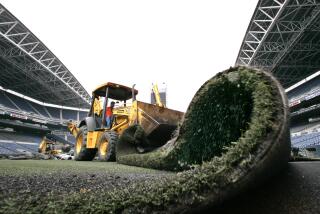It Isn’t Easy Keeping the Lawn Green
- Share via
Though it’s been called a water hog and some horticulturists consider it predictable and boring, few things feel better on bare feet than soft, springy turf grass.
There’s no better place to have a picnic or sit and watch the clouds go by than on a nice patch of grass.
“Lawns are the only plant in the landscape that you can go out and be a part of,” says Martin Gramckow, vice president of Southland Sod Farms in Oxnard. “No other surface renews itself just so you can walk and play on it.”
Of course, a healthy, happy grass makes the cushiest play area. Having a good lawn requires some care, including choosing the right type of grass and maintaining the lawn with proper watering and feeding.
Your first step will be to choose between a warm-season or cool-season grass, says Bruce Johann, assistant manager of Armstrong Garden Center in Irvine.
In general, warm-season grasses, such as the hybrid Bermudas, St. Augustine and zoysia, do the bulk of their growing in the spring, summer and early fall. When the days grow shorter, these grasses tend to stop growing.
Depending on your location and how cold the winter is, they will often turn brown until the following spring, when they start growing again. If you live along the coast where winter tends to be milder, they may hold some color throughout the cold months.
Cool-season grasses, such as tall fescue, which is the most popular grass in Southern California, do the bulk of their growing in the cooler months of late fall, early winter and early spring. While these grasses technically go dormant in the summer months, they tend to stay green throughout the year.
The big difference between cool and warm season grasses besides when dormancy occurs is that cool-season grasses are individual plants that don’t spread, whereas warm-season grasses tend to creep and spread, says Johann.
“If there is damage to your tall fescue, because the plants are individual, you will end up with a bare spot that will have to be filled in and replaced with new sod,” he says. “Warm-season grasses like zoysia and Bermuda will eventually creep over and fill the hole in again.”
Choosing the right grass also means taking into consideration your lifestyle, says Harold Mitchell of the J. Harold Mitchell Co., a San Gabriel company that consults on a wide variety of turf problems.
Do you have children? Do you have pets, especially dogs? Or will the grass be mostly for aesthetics?
Some grasses are more durable than others. Zoysia, for example, holds up to more wear and tear than tall fescue.
Also consider how much you can afford for maintenance. The hybrid Bermudas may be beautiful lawns, but they must be cut by a reel mower, which is substantially more expensive than a standard mower.
Planting
All turf grass can be planted from sod; some can also be planted by stolons, which are small plant plugs that take time to establish. Seed is also sometimes a possibility.
Only warm-season grasses, such as zoysia, can be planted by stolons. Tall fescue can be planted by seed or sod.
In general, fall and spring are the best times to plant grass, says Gramckow. Winter is also a good time, as long as you plant in between rains when the soil isn’t too wet.
Whether you plant sod, stolons or seeds, the preparation is the same.
Start by preparing the soil. “You can’t expect any lawn or plant to do better than the soil preparation,” says Mitchell. “Unfortunately, many people will just dig out the old grass and lay down sod. Although it looks beautiful for a while, it eventually starts to decline.”
Part of preparing the soil includes clearing the ground of weeds, says Gramckow, who suggests watering the area where the new lawn will be so that the weeds grow vigorously and then spraying the area with Round-Up, which will kill the weeds down to the roots.
Next, amend the area with two inches of bagged compost or other amendment that is high in wood products. The compost should be rototilled in six to eight inches deep.
At planting, you can also add an all-purpose lawn food such as a 16-16-16, according to package directions.
Other amendments to ensure even more success include mycorrhizal fungi and soil polymers.
The fungi are microscopic creatures that live on the roots of grass, foraging and collecting water and nutrients, which makes the grass more drought-resistant and stronger, says Mitchell, whose company sells a mycorrhizae for turf.
Drought resistance can also be created by adding a soil polymer, which is a gel-like substance that can absorb at least 150 to 200 times its weight in water, says Robert Burdick, president of Broadleaf P4 in Costa Mesa, which produces P4, a polymer product carried at a variety of nurseries and garden centers.
“When you use P4 in your turf grass, the roots penetrate these little reservoirs of water-storing granules and draw water from them as they need it, which is especially helpful in drought situations,” he says. “Not only do they provide lawns with a constant source of water and cut back on irrigating, they also break up heavy clay, providing aeration and drainage.”
After amendments, Gramckow suggests leveling the area by tying rope on the end of a 2-by-4 board and dragging it around the yard. Also make sure sprinkler heads are a half an inch above the soil surface, so that when you put down the sod, they will be level with it.
If you will be planting seed, sow it on the exposed soil and then cover with a one-fourth-inch layer of more compost or a seed cover. Once seed or sod is in, water well. When sodding a large area, water every 200 to 300 feet so that the sod doesn’t dry out.
Watering
For best results after planting, water new sod the first week three times a day at 7 a.m., 11 a.m. and 2 p.m.; the second week at 7 a.m. and 2 p.m. and the third week only at 7 a.m. Eventually taper back to once every two or three days, adjusting according to weather and season.
To keep grass healthy, proper watering is critical.
“It’s important to water grass like a living thing that has greatly changing water needs over the course of the year,” says J. Michael Henry, University of California cooperative extension area environmental horticulture advisor for Riverside and Orange counties.
“Most lawn problems are a result of too much or not enough water,” he says.
“Lawns should be watered based on need,” agrees Johann, who suggests testing the grass to see if it needs watering by walking on it.
If it springs back readily, then it probably has enough water. But if your footprint is still there a few minutes later and the grass has a blue-gray tinge, it’s time to water.
You can also test for watering readiness by sticking a finger in the soil or digging down with a trowel. The top six inches should dry out before the turf needs water. Watering only when the turf dries out will create a stronger, longer-lived lawn with a well-established root system.
Once established, a lawn should not be watered daily. Instead, water less often with longer watering cycles, such as once or twice a week in the cooler months and three or more times a week in the warmer months. Water until you get deep soil penetration, which could mean up to 30 minutes.
If runoff occurs, break the watering schedule up. Stop watering and wait one to two hours for the water to penetrate again before resuming. Water in the morning or afternoon, but not between 4 p.m. to 4 a.m.
Irrigation systems should be checked regularly to make sure that you have head-to-head coverage and no dry spots. Low-flow sprinkler heads are a good idea, because they minimize runoff.
Grass should be fertilized with an all-purpose turf fertilizer according to package directions and the type of turf you have. Generally, grass should not be fertilized any later than early fall. Feed again in spring and then midsummer.
Turf Types
Although there are many grasses to choose from, these four types tend to do well in Southern California and are generally readily available.
* Hybrid Bermuda: One of the most drought-tolerant lawns, this turf is a warm-season grass with a green, soft texture. It can be kept very short--from one-fourth to half an inch in height, which gives it a putting green appearance. This is a tough grass that can withstand a lot of foot traffic and is generally not bothered by pests. It will go dormant during our cool months but may be over-seeded with poa or rye grass. Plant from sod or stolons. Dethatch every two years or so. Tifgreen is an example of this grass.
* Tall fescue: The most popular turf grass in the Southern California area, this cool-season grass is green most of the year, with upright, soft, fine-textured blades. It can be planted from seed or sod. Tall fescue needs full sun, or it will die off, especially during the winter. It needs about 20% more water than the warm-season turf grasses. It withstands a moderate amount of foot traffic. Marathon is one of the most prevalent of the tall fescues.
* St. Augustine: This is a warm-season grass that can be planted by sod and stolons. A medium coarse-textured grass, it has a succulent texture and emerald green color. It is the most shade tolerant, although it has a fairly high water requirement. The turf needs to be dethatched every two years or so. St. Augustine is highly resistant to most insects and diseases, although chinch bugs can be a problem, causing yellow or brown patches. It will go dormant in the winter months.
* El Toro zoysia: This thick-bladed, rich green grass stands up to a lot of foot traffic. It is also drought tolerant and will take a moderate amount of shade. Although it goes dormant in winter and the grass yellows, it can be dyed for a green look. It is highly resistant to pests and diseases. Plant by stolons or sod. Dethatch every two years or so.






